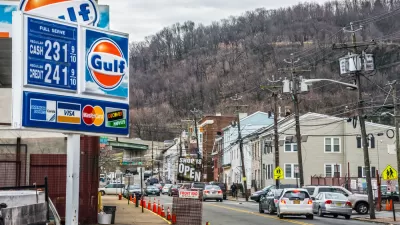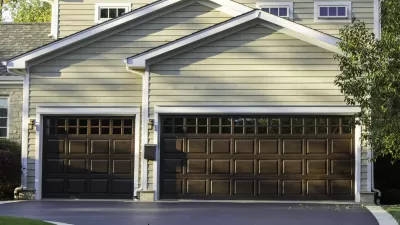After peaking in 2007, new research shows that the rate of vehicle ownership in the U.S. took a dive over the next five years. Researchers argue the growth in car-free households suggests the country has surpassed peak motorization.
New research by Michael Sivak for the University of Michigan Transportation Research Institute [PDF] indicates that the rate of vehicle ownership by the average American household dropped from a high of 2.07 in 2007 to 1.98 by the end of 2012. This may not sound like much, but when considered in the context of other downward trends in miles driven and fuel consumption, Sivak sees a growing consensus that "motorization in the U.S. might have reached a peak several years ago."
Sivak's research also documents the concurrent rise in the percentage of car-free households in 21 of America's 30 largest cities, notes Angie Schmitt. "Growth in car-free households reflects a number of local factors, including the quality of transit, walkability, and income levels, among other factors, according to Sivak. But he says wider social trends are at work as well."
FULL STORY: The American Cities With the Most Growth in Car-Free Households

Study: Maui’s Plan to Convert Vacation Rentals to Long-Term Housing Could Cause Nearly $1 Billion Economic Loss
The plan would reduce visitor accommodation by 25,% resulting in 1,900 jobs lost.

North Texas Transit Leaders Tout Benefits of TOD for Growing Region
At a summit focused on transit-oriented development, policymakers discussed how North Texas’ expanded light rail system can serve as a tool for economic growth.

Why Should We Subsidize Public Transportation?
Many public transit agencies face financial stress due to rising costs, declining fare revenue, and declining subsidies. Transit advocates must provide a strong business case for increasing public transit funding.

How to Make US Trains Faster
Changes to boarding platforms and a switch to electric trains could improve U.S. passenger rail service without the added cost of high-speed rail.

Columbia’s Revitalized ‘Loop’ Is a Hub for Local Entrepreneurs
A focus on small businesses is helping a commercial corridor in Columbia, Missouri thrive.

Invasive Insect Threatens Minnesota’s Ash Forests
The Emerald Ash Borer is a rapidly spreading invasive pest threatening Minnesota’s ash trees, and homeowners are encouraged to plant diverse replacement species, avoid moving ash firewood, and monitor for signs of infestation.
Urban Design for Planners 1: Software Tools
This six-course series explores essential urban design concepts using open source software and equips planners with the tools they need to participate fully in the urban design process.
Planning for Universal Design
Learn the tools for implementing Universal Design in planning regulations.
Ascent Environmental
Borough of Carlisle
Institute for Housing and Urban Development Studies (IHS)
City of Grandview
Harvard GSD Executive Education
Toledo-Lucas County Plan Commissions
Salt Lake City
NYU Wagner Graduate School of Public Service





























